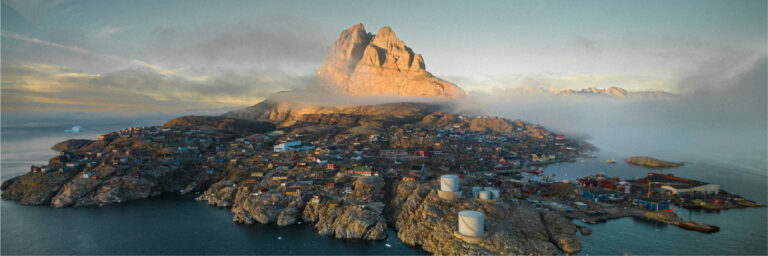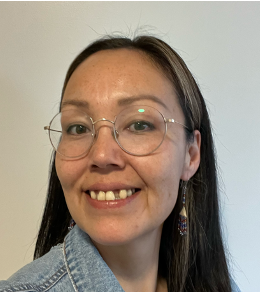Language
Greenland, the world’s largest island, stands at the crossroads of climate change and geopolitical intrigue. Known for its melting ice sheets and shifting ecosystems, the island also harbors a rich linguistic and cultural heritage shaped by its Inuit population. It is within this intricate cultural and linguistic fabric that the profound impacts of today’s changes are most deeply felt. In fact, climate change is leaving an indelible mark on the Greenlandic language, influencing its vocabulary, metaphors, and societal role. Simultaneously, Greenland’s increasing global significance has fueled its independence movement, a powerful expression of cultural pride and autonomy.
A Changing Lexicon
Language evolves alongside changing environments, and in the face of climate change, it must adapt to new realities. In Greenlandic – a language deeply connected to the land and sea – there are countless words for ice, snow, and ocean conditions, things that matter when you rely on them to hunt, travel, or simply get by. Take the word siku, meaning sea ice: it comes in many variations, each capturing a specific detail about thickness, stability, or season.
| Qanisoq Thin Ice | Maneroq Soft snow | Nittaalaq Falling snow | Puttaaq Floating ice | Iluq Packed Sea Ice |
However, as ice melts at unprecedented rates and new climatic phenomena emerge, Greenlandic speakers are developing or adopting terms to describe unfamiliar features of their landscape. Words for new ice formations, warmer winters, and erratic weather patterns are entering the lexicon.
| Pujorak Hazy air caused by warm winters | Sikuaq New ice forming in warmer conditions | Apisseq Unexpected snowfall patterns | Tipitak Erratic weather | Issuaqqissaaq Rapidly thinning ice |
Meanwhile, traditional words tied to a disappearing way of life may fade into obsolescence, carrying with them a wealth of cultural and environmental knowledge. As Greenlandic adapts to describe new environmental realities, these linguistic changes reflect deeper shifts in the daily lives and cultural practices of Greenland’s Inuit communities.
The Cultural Ripple Effect
Greenlandic is not merely a tool for communication but a way of understanding and interacting with the world; a repository of cultural memory, and as it changes, so too does the culture it reflects. Changes in the language mirror disruptions to traditional Inuit practices, such as hunting and fishing*, which are becoming increasingly precarious due to thinning ice and shifting animal migrations.
Fishing remains a cornerstone of Greenland’s economy, sustenance, and cultural identity. Ice conditions have traditionally dictated both the timing and accessibility of fishing, with sea ice providing a stable platform for catching key species like halibut. In recent years, however, thinner—or absent—ice disrupted these patterns, making it more difficult for fishers to reach traditional grounds.
| Qajaq Kayak used for traditional hunting | Qaleraninnut qassutinik Large nets for halibut | Ammassaat Capelin fishing season | Niffi Seasonal fishing openings in ice |
This disruption has impacted not only the immediate livelihoods of fishers but also brought broader economic and cultural consequences to entire communities. Reduced catches, higher operational costs, and increased safety risks have intensified financial strain among those who depend on this vital industry.
Alongside this, the fading relevance—or complete loss—of specific terms and traditions deepens cultural disconnection, especially among younger generations who may feel less rooted in their ancestral heritage. Thus, both economic vulnerability and cultural disconnection contribute significantly to psychological distress within the Greenlandic population.
Language and Mental Health
Climate change is reshaping the emotional landscape of Greenland, where language, the environment and mental health deeply intersect. Greenlandic has long included expressions of respect and gratitude for nature, woven into proverbs, stories, and daily speech. However, as the environment becomes less predictable and more hostile, these expressions may take on a more mournful tone.
| Sila ajunngilaq | The air is good | Gratitude for clean air |
| Immap naqqani inuuneq | Life at the bottom of the sea | Interconnectedness of all living things |
| Nuna ajunngilaq | The land is good | Reverence for the land’s bounty |
Climate anxiety and grief over environmental loss are especially intense in communities so closely tied to the land and sea. For some, the erosion of traditional terminology deepens feelings of loss and disconnection, underscoring the psychological toll of climate change. For others, the evolving language offers comfort and resilience—a way to process emotion and express shared experiences.
As Greenlanders grapple with the emotional toll of a changing environment, education emerges as a vital tool for preserving the language that carries both cultural memory and resilience.
The Role of Language Education
Education plays a critical role in shaping how the Greenlandic language evolves and is passed down to future generations. Efforts to document and preserve traditional vocabulary are gaining momentum, led by initiatives such as the Greenland Language Council (Oqaasileriffik) leading the charge. The council collects, registers, and approves new Greenlandic words while offering guidance on linguistic matters. Similarly, projects like Ole Lund’s work to preserve Eastern Greenlandic aim to document elders’ knowledge and oral traditions before they disappear.
On the other hand, the growing influence of English and Danish—languages that dominate scientific, political, and global discourse—presents both opportunities and challenges. While they offer access to broader conversations on climate change and international affairs, they also risk marginalizing Greenlandic in these critical spaces. Striking a balance between preservation and adaptation is essential to keeping the language vibrant, relevant, and alive for future generations.
Language Shift in Greenland: Key Trends
Around 2000, about 70% of Greenlanders identified as West Greenlandic speakers, 15% as bilingual, and 15% spoke only Danish (Langgård, 2001). Over the next two decades, bilingualism has significantly increased among native West Greenlandic speakers, with more individuals fluent in both Greenlandic and Danish. Meanwhile, the number of monolingual West Greenlandic speakers has declined. First-language Danish speakers with good Greenlandic skills have remained steady, and English is emerging as a growing third language. Although official data are lacking, fluency in both Greenlandic and Danish among native Greenlandic speakers is now very high (Fredriksen & Olsen, 2017).
Geopolitical Aspirations and Independence
Conversations about language in Greenland often open up deeper questions of identity, belonging, and control. In addition to climate challenges, Greenland has increasingly found itself the subject of international interest – most notably during both Donald Trump’s presidencies, when he proposed purchasing the island. While this wasn’t a new idea—the U.S. has attempted to buy Greenland from Denmark several times since the 19th century—it was firmly rejected by Greenlanders, who viewed the proposal as a challenge to their identity and self-determination.

Greenland – The Silent Frontier
Global Perspectives
Discover Greenland’s rise from a remote icy land to a global hotspot. Explore its history, vast resources, and strategic importance in shifting geopolitics. This three-chapter series reveals why Greenland is now at the center of the world stage. Read
That rejection is part of a broader movement: Greenland’s drive for independence has gained momentum in recent years, fueled by a desire to break free from Denmark and take control of its own future. This aspiration deeply resonates with Greenlanders, many of whom see sovereignty as essential to protecting their land, culture, and language. Yet, the path to independence is complex, requiring navigation of economic challenges, political readiness, and international relations.
A Voice in the Global Arena
As Greenland pursues greater sovereignty and grapples with climate challenges, its rising global importance offers a unique chance to assert cultural identity on the world stage. Greenlanders are increasingly blending traditional language with global scientific and political discourse, bridging local wisdom and international dialogue.
Greenlandic Language in International Debates
Around 2000, about 70% of Greenlanders identified as West Greenlandic speakers, 15% as bilingual, and 15% spoke only Danish (Langgård, 2001). Over the next two decades, bilingualism has significantly increased among native West Greenlandic speakers, with more individuals fluent in both Greenlandic and Danish. Meanwhile, the number of monolingual West Greenlandic speakers has declined. First-language Danish speakers with good Greenlandic skills have remained steady, and English is emerging as a growing third language. Although official data are lacking, fluency in both Greenlandic and Danish among native Greenlandic speakers is now very high (Fredriksen & Olsen, 2017).
The reshaping of Greenlandic in response to climate change and independence efforts reflects the interconnectedness of local and global challenges. New terms and concepts emerging in Greenlandic can offer unique insights, enriching both the language and the global understanding of climate and geopolitical shifts. Greenland’s ability to articulate its experiences in its native language—while also participating in international advocacy—ensures its voice is heard in the global arena.
Conclusion
Climate change and geopolitical aspirations have profound impacts on Greenlandic identity, reshaping the island’s language and cultural heritage. For Greenlanders, the evolution of their language serves as both a record of loss and a testament to resilience, highlighting the challenges of preserving tradition while navigating a warming world.
Efforts to document, nurture, and adapt Greenlandic are crucial for ensuring that it remains a living, evolving tool for communication and cultural expression. Meanwhile, Greenland’s independence movement underscores the population’s determination to protect their land and define their future. By asserting their linguistic and cultural heritage, Greenlanders honor their past while forging a path forward in an ever-changing world.
The absence of sea ice this year is a poignant example of how climate change is not just an abstract global issue but a deeply personal and immediate challenge for Greenlanders. As the ice retreats, it takes with it not only a way of life but also a piece of cultural heritage. The question now is how Greenlanders will continue to adapt while preserving the essence of what makes their land and traditions unique. In the face of these challenges, their resilience remains a beacon of hope.

Angerdlartúnguak Fleischer
Teacher / Translator
Born in Aasiaat and based in Uummannaq, Angerdlartúnguak Fleischer has worked as a primary school teacher since 2011. She has also been active as a freelance translator and transcriber since 2020, focusing on Greenlandic and Danish. With deep roots in Greenlandic language and culture, she contributes to local language preservation through both education and practical linguistic work.
